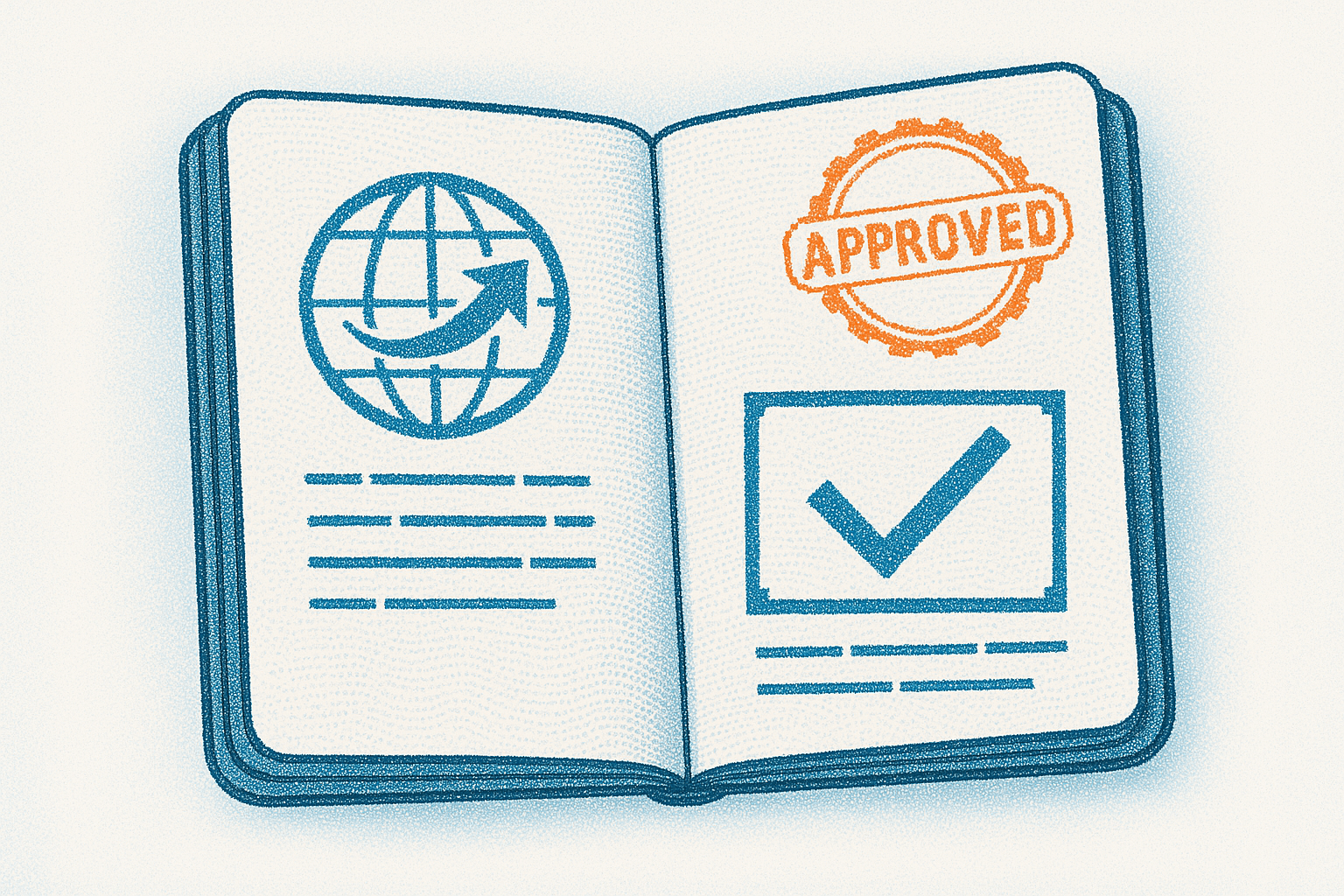Business Travel Compliance 2025: Complete Step-by-Step Guide
Master business travel compliance in 2025 with this complete guide. Learn policy enforcement, duty of care, expense management, and AI tools that automate compliance.

AI travel assistants have changed business travel compliance in 2025. Tools that once required employees to memorize spending caps and booking rules now flag violations in real time, before purchase. Systems track employee locations automatically instead of relying on travelers to check in. Expense reports that took days to review now process in minutes with automated receipt matching.
This guide explains what travel compliance means in this changing landscape, the risks companies face when travelers bypass approved systems, and how to build a program that keeps your team safe, your operations efficient, and your costs under control.
What Is Business Travel Compliance?
Business travel compliance is the set of company policies and legal requirements that govern how your team books trips, stays safe on the road, and documents expenses. Companies that do it right see travelers move smoothly through borders, hotels, and expense approvals. Companies that get it wrong face denied reimbursements, tax penalties, and legal liability.
Business travel compliance covers four areas:
- Policy alignment means your company's travel rules define who approves trips, which booking platforms employees must use, and spending limits for flights, hotels, and meals. Written policies prevent rejected expense reports and booking delays.
- Duty of care represents industry standards and best practices that encourage employers to protect travelers before, during, and after a trip. Companies provide health briefings, track employee locations in real time, and vet travel vendors. Courts use these practices to evaluate negligence when employees are harmed during business travel, even though no specific law lists required duty of care steps.
- Financial integrity tracks how business trips create tax obligations. Employees who work multiple days in another country can trigger payroll tax requirements or create permanent establishment risk for your company. Systems that connect booking records to expense categories provide the documentation tax authorities require during audits.
- Data privacy adherence ensures personal information in travel itineraries meets data protection regulations now enforced in most countries. You need documented policies about what data employees can store on devices and in cloud systems when border agents conduct inspections.
Building an effective compliance program requires systems that enforce policies, track expenses, and protect travelers without adding friction to the booking process.
5 Key Elements of an Effective Business Travel Compliance Program
A solid travel compliance framework keeps you legal, safe, and on budget every time you hit the road. The five components below work only when they click together. Treat them like gears in the same watch, not separate checklists.
1. Clear and Accessible Travel Policies
Clear travel policies reduce unauthorized bookings and budget leakage by giving employees visibility into spending rules before they book. Written policies define approval paths, preferred vendors, and spending caps. Your policy should specify who can approve travel requests, which booking platforms employees must use, and maximum amounts for flights, hotels, meals, and ground transportation. Post the policy where employees can find it before they book, and update it quarterly to reflect regulatory changes.
2. Automated Policy Enforcement
Automated enforcement minimizes human error and frees managers from manual oversight by catching violations at the point of booking. AI-powered travel assistants like Otto the Agent check employee selections against company rules in real time, flagging out-of-policy options before purchase and suggesting compliant alternatives that still meet travel needs. This gives companies visibility into booking decisions as they happen, prevents policy violations from reaching expense reports, and reduces the administrative burden of reviewing and rejecting non-compliant bookings.
3. Expense and Receipt Integration
Integrated expense systems reduce fraud, improve audit readiness, and accelerate reimbursement cycles by eliminating manual data entry. Digital expense tools capture receipts and sync data with finance systems automatically. When employees photograph a receipt, the system matches it to the correct trip, applies the appropriate expense category, and calculates totals. The data flows directly into your accounting software, creating an audit trail without manual input from finance teams.
4. Safety and Risk Management Processes
Active safety management reduces legal liability and travel-related incidents by protecting travelers before problems occur. Pre-trip risk reviews, real-time tracking, and 24/7 emergency support ensure traveler protection. Before travel, assess destination risks including health advisories, political instability, and weather threats. During travel, GPS tracking shows employee locations, and automated alerts notify travelers and managers of emerging threats. Emergency contact systems connect travelers to support within minutes.
5. Continuous Monitoring and Reporting
Continuous monitoring tracks every booking, expense, and policy violation in real time so you can identify overspending and non-compliance as it happens. Dashboards show what percentage of trips stay within policy, which employees book outside approved channels, and how much your team spends on flights, hotels, and meals each month. Monthly reports reveal patterns: if five employees consistently exceed hotel caps in the same city, you know to negotiate corporate rates or adjust limits. When auditors request documentation, you can pull complete trip records with receipts, approval chains, and policy compliance status in minutes instead of days.
How to Implement Business Travel Compliance Measures
Building a compliance program requires systematic assessment, clear ownership, and tools that enforce policies without adding administrative burden. Follow these five steps to establish accountability, reduce violations, and create audit-ready documentation.
Step 1: Assess Current Processes
Identify where your current travel management breaks down before you implement new solutions. Review how employees book trips, submit expenses, and handle travel changes. Document specific gaps: which employees book outside approved platforms, how long expense reports take to process, and whether anyone tracks employee locations during travel. Map the full journey from booking request to final reimbursement to see where policy compliance fails.
Step 2: Define Compliance Frameworks and Ownership
Assign specific people to manage each compliance area so every responsibility has a clear owner. Designate one person to manage policy updates, a second to monitor spending patterns, and a third to oversee traveler safety protocols. Create compliance dashboards that track key metrics and schedule quarterly reviews to assess performance and adjust policies based on what the data shows.
Step 3: Adopt Technology to Simplify Compliance
Select tools that integrate booking, expense tracking, and safety monitoring into a connected system. Otto consolidates these functions in one platform: it enforces policies automatically during booking, tracks spending against budgets with proactive alerts, monitors traveler locations and sends safety notifications when risks emerge, and creates complete audit trails that link every booking, receipt, and approval. This integration eliminates the manual work of checking compliance across disconnected systems.
Step 4: Train and Engage Employees
Employees follow policies they understand and see value in. Build awareness through onboarding sessions that explain why policies exist and how to follow them. Send short email reminders or app notifications to educate travelers about new regulations or policy changes before their next trip. Consider offering recognition or rewards for employees who consistently follow compliance procedures, reinforcing that compliance protects both them and the company.
Step 5: Review and Improve Quarterly
Quarterly reviews reveal compliance problems early so you can fix them before they drain budgets or create audit risk. Track spending accuracy, policy adherence rates, and incident response times. Analyze the data to identify problems: which routes exceed budget most often, which departments violate policies most frequently, and where approval bottlenecks slow travel decisions. Apply these insights to refine policies, negotiate better rates, or adjust approval thresholds.
Building More Compliant Business Travel in 2025
Business travel compliance in 2025 requires clear policies, automated enforcement, integrated expense tracking, active safety management, and continuous monitoring. Companies that implement these five elements protect travelers, control spending, and avoid the tax penalties and legal liability that come from fragmented systems and manual oversight.
Otto handles compliance automatically for both travelers and operations leaders. For travelers, Otto flags out-of-policy options during booking and suggests compliant alternatives, eliminating rejected expense reports and reimbursement delays. For operations managers and finance teams, Otto tracks spending against budgets, monitors employee locations during travel, and creates audit-ready documentation that connects every booking, receipt, and approval without manual work.
Ready to see how Otto keeps your team compliant and your operations efficient? Try Otto today.



